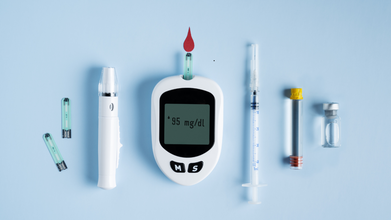- Health Conditions A-Z
- Health & Wellness
- Nutrition
- Fitness
- Health News
- Ayurveda
- Videos
- Medicine A-Z
- Parenting
World Mental Health Day: Understanding Addiction As A Disease, Not A Habit

Understanding Addiction As A Disease, Not A Habit
When people think of addiction, the image often conjured is one of recklessness or irresponsibility. Marc Lewis in "The Biology of Desire" explains that addiction rewires the brain’s circuitry, fostering a cycle of craving and compulsion. This means that the addicted brain doesn’t simply “want” substances—it feels as if it needs them for survival. Addiction fundamentally changes the brain’s reward system, making it increasingly difficult for individuals to make rational choices about their substance use.
One of the biggest obstacles to recovery is the stigma surrounding addiction. When society views addiction as a personal failure or a chosen habit, it creates barriers to seeking help. Russell Brand expresses in his book "Recovery: Freedom from Our Addictions", that addiction can take many forms beyond substances, including work, stress, and relationships. There is a universal human tendency to seek external sources of comfort when faced with internal pain. This perspective encourages a more compassionate approach to those suffering from addiction, recognizing that it is not just about the substance or behavior, but about the pain that drives it. The road to recovery is complex, but breaking the cycle is possible with the right tools. David Sheff stresses that understanding addiction as a disease, rather than a moral failing, is crucial to removing the stigma that often prevents people from seeking help.
There are significant and profound impacts addiction can have on individuals, families, and communities. A critical shift in understanding addiction is recognizing it not as a mere weakness, or a bad habit, but as a complex, chronic disease that affects both the brain and behavior. It is not just a matter of choice but a deeply complex disease rooted in brain chemistry, emotions, and social context. This perspective can radically change how we approach treatment, offering a more compassionate and scientifically grounded path to recovery. Understanding addiction as a disease opens doors to new treatment approaches, greater empathy, and more sustainable recovery.
In "Unbroken Brain", Maia Szalavitz reframes addiction as a learning disorder—an interaction between brain chemistry, life circumstances, and learned behaviors that lead to compulsive drug use. She asserts that addictive behaviors fall along a spectrum, much like traits in other neurological conditions, and should be understood as coping mechanisms for underlying issues rather than mere indulgences. It is merely a way to cope with emotional pain.
Addiction is so much more than a habit. Substances alter brain chemistry, particularly in the areas related to reward, motivation, and self-control. Recovery is not simply about choosing to quit.
Addiction hijacks the brain’s prefrontal cortex—the area responsible for decision-making, self-control, and judgment. As a result, people suffering from addiction are often unable to regulate their behavior, even when they want to.
The brain’s reward system reinforces substance use by releasing dopamine, the chemical associated with pleasure and reward. Over time, the brain becomes dependent on this chemical surge, leading to tolerance (needing more of the substance to feel the same effect) and withdrawal symptoms when the substance is not available.
Acknowledging addiction as a disease requires a holistic, multi-faceted approach to treatment—one that addresses the psychological, biological, and social factors that contribute to its onset and perpetuation. It is important to understand the emotional drivers and triggers behind addictive behaviors. Viewing addiction as a disease, rather than a habit, opens the door to more effective, compassionate, and comprehensive treatment.
It is important to challenge outdated narratives and promote a more nuanced understanding of addiction.
In practice, this means that treatment should extend beyond simply detoxifying the body from substances. It should encompass therapy that helps individuals understand the emotional and psychological reasons behind their addiction. Additionally, support systems—family, group therapy, or peer support groups—are critical in sustaining long-term recovery.
Apps like letsgethappi give people access to cognitive tools for managing cravings, stress, and emotional triggers. This kind of digital support is a game-changer, especially for those who may not have immediate access to in-person treatment or prefer more discreet care options.
Viewing addiction as a disease rather than a habit shifts the focus from blame to understanding. It encourages us to approach addiction with empathy, knowing that it is rooted in deep neurological and emotional mechanisms. When we break free from the idea that addiction is a mere choice, we open the door to more effective treatment and, ultimately, a healthier society.
Whether through innovative therapies, supportive apps, or community-based programs, the path to healing begins with understanding addiction for what it truly is—a chronic disease that requires care, patience, and resilience. Only by breaking this cycle can we offer those struggling with addiction the opportunity to reclaim their lives.
World AIDS Day 2025: Experts Explain Which HIV “Facts” Are Actually Myths

Credits: Canva
World AIDS Day is marked across the globe every year on 1 December to draw attention to HIV and AIDS. In India, the day is observed through awareness drives and community-level programmes held nationwide. The National AIDS Control Organization (NACO), which functions under the Ministry of Health and Family Welfare, leads these efforts and brings people together to support the ongoing battle against the illness.
This year, the government reported a strong decline in HIV cases, noting 49 per cent fewer new infections since 2010, an 81 per cent fall in deaths linked to AIDS, and a 75 per cent drop in mother-to-child transmission between 2010 and 2024.
The update, shared on Sunday for World AIDS Day 2025, also underlines how myths continue to harm people living with HIV. Misconceptions remain widespread, including the belief that the virus spreads through simple physical contact.
What is HIV/AIDS?
The Human Immunodeficiency Virus (HIV) harms the body by attacking helper T-cells, which are vital for immunity. Acquired Immunodeficiency Syndrome (AIDS) develops when these cells fall to very low levels, leaving the body exposed to infections and diseases, as described by the Mayo Clinic.
Common HIV Myths That You Should Know About
There are many myths surrounding HIV/AIDS that people continue to believe, though experts have clarified the truth behind them: Dr Kajal Singh, Associate Professor, Obstetrics and Gynaecology Department, NIIMS Medical College and Hospital, Greater Noida, helped us debunk the myths.- It is a myth that HIV spreads through coughing, touching or shaking hands. Routine contact or a cough does not transmit the virus. Transmission can occur only when the skin has open sores or breaks that allow the virus to enter.
- It is a myth that a person diagnosed with HIV will survive only a short time. With proper treatment that keeps the virus suppressed, people with HIV can live for many years.
- It is a myth that every child born to an HIV-positive mother will also have HIV. With antiretroviral therapy, a planned C-section and other precautions, the chance of passing the virus to the baby can be reduced to below 2 per cent.
- It is a myth that HIV, being a viral infection, cannot be linked to the use of antibacterial or antifungal medicines. Since HIV weakens immunity, those living with it may be prone to common bacterial and fungal infections and may need such medicines for long periods.
- It is a myth that there is no risk when two or more HIV-positive partners are intimate. Unprotected sex can still allow tougher or drug-resistant strains of the virus to evolve and spread.
- It is a myth that people who do not show symptoms cannot have HIV. It can take years for signs to appear, and the only way to confirm the infection is through testing.
- It is a myth that taking medicines before intercourse can fully prevent HIV. Pre-exposure prophylaxis lowers the risk but does not remove it entirely.
World AIDS Day, observed each year on December 1, is a time to pause, acknowledge and renew our commitment. It pays respect to those who lost their lives to AIDS-related illnesses, offers support to people living with HIV and reminds the world that prevention, treatment and rights-based care remain essential. The theme for 2025, “Overcoming disruption, transforming the AIDS response”, urges countries to build stronger systems, widen access to services and uphold the dignity of all communities affected by HIV.
Who Was Ludwig Minelli, Founder of the Swiss Right-to-Die Organization, Who Died by Assisted Suicide at 92?

Credits: AP
Ludwig Minelli, 92, died on Saturday just days before his 93rd birthday, which would have been on December 5. He was the founder of Swiss right-to-die organization Dignitas. He has died by assisted suicide.
The members of organization paid tribute to him and said that he had always led a "life for freedom of choice, self-determination, and human rights".
Right-To-Die By Minelli
Minelli founded Dignitas in 1998, which has helped many people to choose how they wish to die with dignity. He however began his career as a journalist and worked as a correspondent for the German news magazine Der Spiegel. He then studied law and that is when his interest in human rights took off.
Throughout his life, he campaigned for the right to die and gave Dignitas the slogan: "dignity in life, dignity in death".
"I am persuaded that we have to struggle in order to implement the last human right in our societies. And the last human right is the right to make a decision on one's own end, and the possibility to have this end without risk and without pain," he said in a 2010 BBC interview.
He founded Dignitas after he split from an older Swiss assisted dying organization, Exit, because he said the rules felt too restrictive.
The reason for Dignitas to become famous was because the way it operated. Dignitas offered assisted suicide to non-Swiss citizens who travel to Switzerland because assisted dying is not permitted in their own countries. In a 2008 interview to Der Tagesspiegel, he said that Dignitas assisted 840 people to die, and 60% of them were Germans.
His Life Amid Criticism And Legal Battles
While he devoted his life for a cause, he was not spared from criticism. He was often criticized for an alleged lack of transparency over the financial dealings of the organization. He was further criticized for offering assisted dying options to those who were not terminally ill, but wanted to end their lives. He also faced numerous legal battles, and many of which were also appealed to Swiss apex court.
The Wins He Made
As per Dignitas, his work had a lasting influence. In 2011, the European Court of Human Rights announced the right of a person capable of judgment to decide on the manner and the time of their own end of life.
While in his own country, assisted dying was permitted under Swiss law since 1942, under strict condition, of course, Euthanasia still remains illegal there.
The main difference is that in Switzerland, a physician cannot administer a lethal injection, which is what euthanasia is. However, a physician can provide the means for a person to end their own life, and the individual must perform the final act themselves.
The legality of assisted suicide is based on Article 115 of the Swiss Criminal Code from 1942, which prohibits assistance only if motivated by selfish reason. The conditions for assisted suicide includes that the assistance must not be for selfish motives and must be provided to someone of sound mind who has made a self-determined and enduring decision to die. The person must also be suffering from an unbearable and uncontrollable condition.
Your Butt Shape Could Be a Clue to Your Diabetes Type; Here’s How

Credits: Canva
The shape of your gluteus maximus, the largest muscle in your backside, may offer surprising clues about your likelihood of developing diabetes. New research suggests that the contours of this major muscle change with age and health conditions, helping scientists better understand how fitness, muscle health, and metabolism are connected.
Ageing, Weight, and Diabetes: What We Already Know
For years, the NHS has warned that ageing and excess weight increase the risk of developing Type 2 diabetes. However, this new study goes beyond traditional measures, proposing that the shape of the gluteus maximus itself shifts as people age or develop conditions such as osteoporosis or diabetes. These subtle muscular changes could provide valuable information about a person’s metabolic health.
Why the Gluteus Maximus Matters
Researchers from the University of Westminster highlighted that the gluteus maximus plays a key role not just in movement but also in metabolic regulation. Healthy, well-maintained muscles can improve blood sugar control and reduce the burden on organs involved in glucose processing.
Dr Marjola Thanaj, co-author of the study from the university’s Research Centre for Optimal Health, explained, as reported by Independent: “People with higher fitness, as measured by vigorous physical activity and hand grip strength, had a greater gluteus maximus shape, while ageing, frailty and long sitting times were linked to muscle thinning.”
Mapping the Muscle
To understand these differences, researchers used advanced MRI 3D mapping to create a detailed anatomical model of the gluteus maximus. By analyzing more than 61,000 MRI scans from the UK Biobank database, they discovered that the shape, not the size, of the muscle varied significantly between individuals with diabetes and those without it.
What the Study Found
The MRI analysis revealed distinct, sex-specific patterns linked to Type 2 diabetes. Among male participants living with the disease, those classified as “frail” showed widespread muscle shrinkage across the gluteus maximus, indicating a loss of muscle quality and strength.
Women with diabetes, on the other hand, had enlarged muscle shapes — not because of increased muscle strength, but because of fat infiltrating the muscle tissue. This type of fat infiltration often signals declining muscle function and poorer metabolic health.
Dr Thanaj said these patterns underline a crucial point: men and women can experience the same illness in very different biological ways, which may influence diagnosis and treatment strategies in the future.
Why Maintaining Muscle Mass Matters
Beyond appearance or strength, muscle health is essential for long-term wellbeing. Maintaining muscle mass supports blood sugar regulation, reduces the risk of cardiovascular disease, and lowers the likelihood of developing fatty liver disease, all conditions closely linked to metabolic health.
Professor Louise Thomas, senior author of the study, told The Times: “Maintaining muscle mass as we age is one of the most important things we can do for our long-term health. If people understand how important their muscles are, and make small changes to keep them healthy, that could have a huge impact on disease across the population.”
Small Steps to Strengthen Your Glutes
Improving glute muscle health doesn’t require intense gym sessions. Simple actions such as taking the stairs instead of the lift, adding squats or lunges to your routine, or breaking up long periods of sitting can help tone and strengthen the gluteus maximus.
© 2024 Bennett, Coleman & Company Limited

